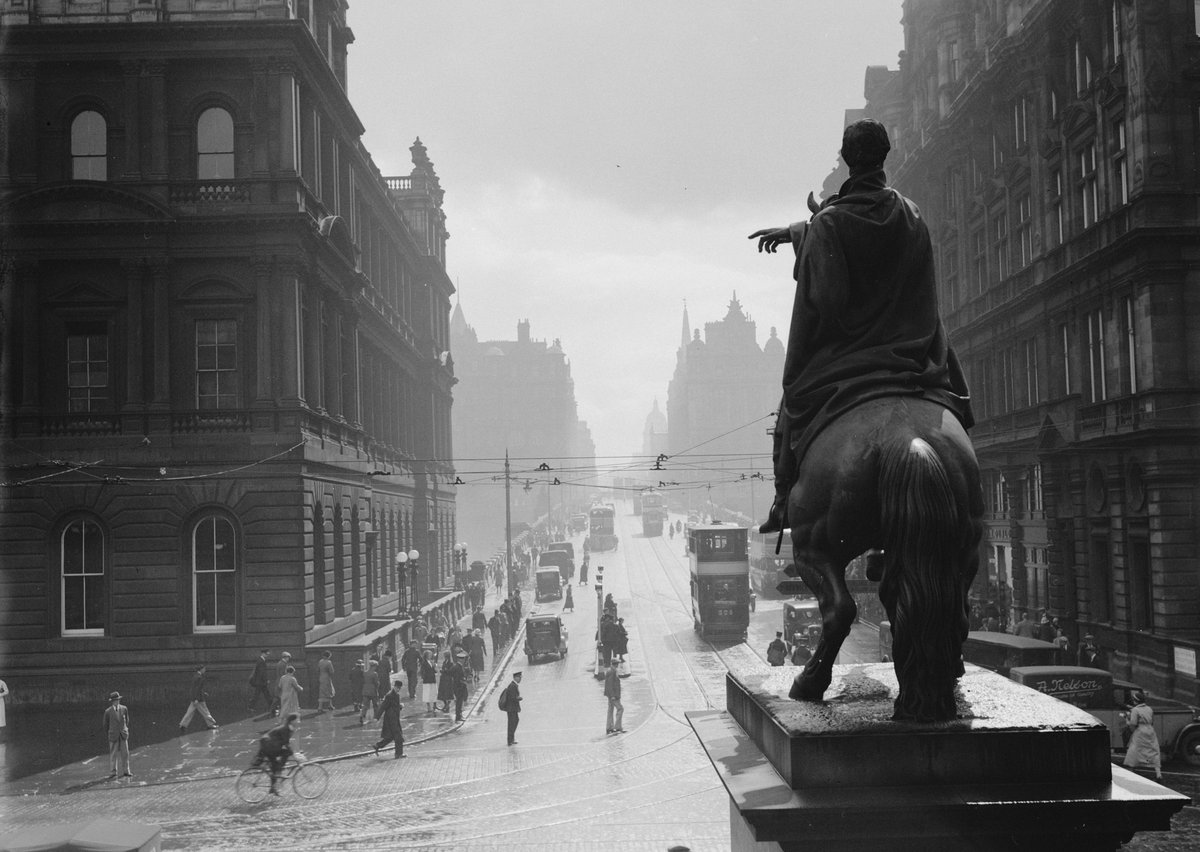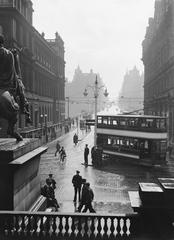
Equestrian Statue of the Duke of Wellington Edinburgh: Visiting Hours, Tickets, and Guide
Date: 14/06/2025
Introduction
The Equestrian Statue of the Duke of Wellington in Edinburgh is a distinguished landmark representing both British military history and Scottish civic identity. Situated at the prominent intersection of Princes Street, Waterloo Place, and North Bridge, this bronze monument commemorates Arthur Wellesley, the 1st Duke of Wellington—renowned for his victory at the Battle of Waterloo in 1815 and his lasting influence in British politics. Created by the celebrated Scottish sculptor Sir John Robert Steell and unveiled in 1852, the statue exemplifies Victorian grandeur and neoclassical artistry. Its continual presence as a focal point in the city’s urban landscape, coupled with local traditions like the placement of a traffic cone atop the Duke’s head, highlights both Edinburgh’s rich heritage and its characteristic sense of humor.
Freely accessible at all hours, the statue offers a rewarding stop for history enthusiasts, art lovers, and city explorers alike. Its location near other major attractions—such as the General Register House, Princes Street Gardens, and Edinburgh Castle—makes it an essential part of any visit to Scotland’s capital. This comprehensive guide covers the history, artistic features, visitor information, and unique cultural elements that make the Equestrian Statue of the Duke of Wellington a must-see Edinburgh landmark (Tovisorga.com, Evendo, Edinburgh Live).
Table of Contents
- Introduction
- Origins and Commissioning of the Statue
- Unveiling and Public Reception
- Artistic Features and Symbolism
- Historical Context: The Duke of Wellington’s Legacy
- Significance for Edinburgh and Scotland
- Visiting Information
- Conservation and Public Interaction
- Related Monuments and Commemoration
- Timeline of Key Events
- Frequently Asked Questions (FAQ)
- Conclusion and Visitor Tips
- References
Origins and Commissioning of the Statue
The Equestrian Statue of the Duke of Wellington was commissioned in the mid-19th century to honor Arthur Wellesley’s pivotal military victories and statesmanship. Sir John Robert Steell, a leading Scottish sculptor, was chosen for his remarkable ability to depict lifelike figures and his strong civic ties. The statue’s placement outside the General Register House underscores its symbolic significance, marking a gateway to Edinburgh’s New Town and reinforcing the city’s connections to broader British history (Tovisorga.com).
Unveiling and Public Reception
Unveiled on June 18, 1852—thirty-seven years to the day after the Battle of Waterloo—the statue’s inauguration was attended by dignitaries and large crowds, reflecting the immense esteem in which Wellington was held. The event was emblematic of the Victorian era’s penchant for celebrating military and civic leaders through grand public monuments. The statue quickly became a prominent landmark and has remained a source of local pride ever since (Tovisorga.com).
Artistic Features and Symbolism
The statue is a striking example of neoclassical public art. It depicts the Duke in full military regalia, mounted on his famed horse Copenhagen. The detailed bronze work and imposing granite pedestal convey both strength and dignity. The Duke’s posture and the horse’s dynamic stance symbolize leadership and martial prowess. The craftsmanship exemplifies the Victorian values of permanence and public commemoration.
Historical Context: The Duke of Wellington’s Legacy
Arthur Wellesley, 1st Duke of Wellington, was one of Britain’s most prominent military commanders, rising to fame for his leadership in the Napoleonic Wars and at Waterloo. His later role as Prime Minister and his political influence during a time of significant national change made him a fitting subject for commemoration throughout the UK.
Significance for Edinburgh and Scotland
The statue’s location and scale reflect Scotland’s role in the United Kingdom and the city’s ongoing tradition of monumental public art. It stands as a testament to Edinburgh’s historical and cultural stature, and—along with nearby monuments—contributes to a civic landscape rich in memory and meaning.
Visiting Information
Visiting Hours
The Equestrian Statue of the Duke of Wellington is outdoors in a public space and can be visited at any time, day or night, throughout the year. For the best views and photographs, daylight hours are recommended.
Ticketing
There are no tickets or entry fees required. The statue is freely accessible to all.
Accessibility
Located at a central intersection, the site is easily reached by foot, public transport (bus, tram, and nearby Waverley Station), or private vehicle. The pavement is generally flat and well-maintained, making it wheelchair-friendly, although it can become busy during peak hours.
Travel Tips
- Visit during early morning or late afternoon for softer light and fewer crowds.
- Combine your visit with other nearby attractions, such as Princes Street Gardens, the Scott Monument, or the Royal Mile.
- Use public transport when possible due to limited parking and city center traffic.
Nearby Attractions
- General Register House: Home to Scotland’s national archives.
- Princes Street Gardens: Ideal for a relaxing stroll.
- Edinburgh Castle: Just a short walk uphill.
- Royal Scots Greys Museum: Celebrates Scotland’s military history.
- St Giles’ Cathedral and Scott Monument: Within easy walking distance.
Guided Tours and Events
The statue is frequently included in city walking tours focused on Edinburgh’s history, military heritage, or public art. While there are no regular special events at the monument itself, it often serves as a focal point during commemorative ceremonies such as Remembrance Day.
Best Photo Spots
- Across Princes Street for a full view with the cityscape in the background.
- Near the Balmoral Hotel for a dramatic urban contrast.
- Early morning or evening for optimal lighting.
- Include the traffic cone if present for a uniquely Edinburgh photo.
Conservation and Public Interaction
The statue is maintained by local authorities in conjunction with heritage organizations. Regular cleaning and restoration preserve its condition. The tradition of placing a traffic cone on the Duke’s head, while less frequent than in Glasgow, is a light-hearted aspect of local culture and adds to the statue’s charm.
Related Monuments and Commemoration
The Duke of Wellington is commemorated with statues in other UK cities, including Glasgow and London. Edinburgh’s monument is notable for its formal grandeur and integration into the city’s historical narrative.
Timeline of Key Events
- 1815: Victory at the Battle of Waterloo.
- 1852: Statue unveiled on June 18.
- Present Day: Maintained as a central Edinburgh landmark and cultural icon.
Frequently Asked Questions (FAQ)
Q: What are the visiting hours for the Equestrian Statue of the Duke of Wellington in Edinburgh?
A: The statue is accessible 24/7 as it is outdoors.
Q: Is there an entry fee or ticket required?
A: No, the statue is free to visit.
Q: Is the statue wheelchair accessible?
A: Yes, the area is generally accessible, but be mindful of crowds during busy times.
Q: Are guided tours available?
A: Yes, many walking tours of Edinburgh include the statue.
Q: What is the significance of the traffic cone on the statue?
A: It is a local tradition reflecting Edinburgh’s playful spirit.
Q: What other attractions are nearby?
A: General Register House, Princes Street Gardens, the Scott Monument, Edinburgh Castle, and St Giles’ Cathedral.
Conclusion and Visitor Tips
The Equestrian Statue of the Duke of Wellington stands as a proud symbol of Edinburgh’s historical, artistic, and cultural vitality. Its central location, free access, and rich narrative make it an unmissable stop for any visitor. For the best experience, visit during daylight hours, consider joining a guided tour, and explore the many nearby attractions that illuminate Edinburgh’s storied past.
Stay updated on events, tours, and visitor information by downloading the Audiala app and consulting official Edinburgh tourism resources. The Duke of Wellington statue is more than just a monument—it is a living part of the city’s heritage, inviting exploration and appreciation from all who pass by.
References
- Why is there a statue of Wellington in Edinburgh? (Tovisorga.com)
- Monument to Wellington (Evendo)
- Edinburgh statue that’s defiantly hogged the pavement for more than 170 years (Edinburgh Live)
- Royal Scots Greys Museum
- Edinburgh Castle
- Truly Edinburgh: Edinburgh Monuments and Statues
- Edinburgh Expert: Equine Statues in Edinburgh
- Equestrian Statue: Wellington, Duke of



















































































